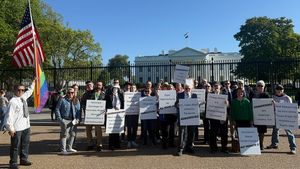Both temperatures and gun crimes are on the rise, and experts are saying there's a relation.
A study recently published in The Journal of the American Medical Association revealed that areas experiencing abnormally high temperatures often also report increased shootings, finding correlation between the phenomenons.
Dr. Vivian H. Lyons, an epidemiologist at the University of Washington who led the study, said that the report also found evidence of causation.
"The analytic technique that we used let us really disentangle if it’s just hotter temperatures in the summer or is today hotter than it should be for this season, and what is the risk of that daily temperature on firearm violence,” she told The Trace.
Researchers from the University of Washington and Boston University looked at the 100 US cities with the highest rates of gun violence between 2015 and 2020, and found that most incidents occurred on days with moderate heat, but the hottest days saw the most shootings.
But it's not the rising temperatures that are directly causing gun violence, rather the conditions people in low-income communities endure when climate change sets in.
"These bigger structural issues are what is forcing people outside of their homes and getting them in situations where conflict arises in their local neighborhoods,” sociologist Dr. Daniel Semenza added. “This study points out that this is a much bigger issue, and if we’re talking about climate change in a longer term, that there have to be bigger investments in cooling and homes.”
While shifting to green infrastructure can be costly, Semenza said that cities can individually take inexpensive action that will benefit their communities, such as reducing asphalt and planting trees. A recent study from the University of Pennsylvania showed that even low-cost home renovations, such as installing new windows, reduced shootings by 13 percent.
The biggest factor that curtails gun violence is proper heating and cooling systems in the home, which many minority and low-income communities lack access to. Older buildings are typically the least expensive to live in, as well as the least likely to have updated air conditioning or heat. Despite this, these areas are the least likely to receive aid, a trend known as environmental racism.
Reverend Vernon K. Walker in Boston leads the community outreach program, CREW, which helps prepare underserved communities for summer temperatures by distributing cooling kits and AC units. He believes investing in those areas is crucial to their residents' survival.
“The communities that we focus on are communities that have been historically redlined and disinvested,” Walker said. “We focus on getting resources to these communities because they are the most vulnerable.”
- Lake Oswego Community Holds Vigil Following Club Q Shooting ›
- Real Life Celebrities: Erica Ford of Life Camp ›
- Climate Change Is Dramatically Transforming the Arctic ›
- Club Q Survivors Can't Afford Hospital Bills Post Shooting ›
- How Women of Color Are Bearing the Brunt of Climate Change ›
- How Climate Change Leaves Women at Risk of Domestic Violence - Advocate Channel ›
- Climate Advocacy Group Vows to Stop Disruptive Protests - Advocate Channel ›
- The Ozone Will Be Repaired Within Decades, UN Report Finds - Advocate Channel ›
- Virginia School Remains Closed After 6 Year Old Shoots Teacher - Advocate Channel ›
- 36 Mass Shootings Occurred in the First Three Weeks of 2023 - Advocate Channel ›
- Denver Public Schools Close For Mental Health Day Following Several Shootings | AdvocateChannel.com ›
- 3 Children Dead in Shooting at Nashville Private Christian School | AdvocateChannel.com ›
- Gun Violence Has Impacted Most US Families, Survey Finds | AdvocateChannel.com ›
- Schools Ban Backpacks Before Government Bans Guns | AdvocateChannel.com ›
- Black Alabama Community Flooded With Sewage Finally Sees Justice | AdvocateChannel.com ›
- More Americans Want Gun Control Than Gun Protections | AdvocateChannel.com ›
- Georgia Gun Store Owner Closes Shop Because of Mass Shootings | AdvocateChannel.com ›
- North Carolina Makes it Legal to Purchase Pistols Without a Permit ›
- Gunman Livestreamed Mass Shooting at Louisville Bank That Left 5 Dead ›
- Miami Beach Sets Curfew After Second Spring Break Shooting ›
- California Experiences Third Mass Shooting in Three Days ›



















































